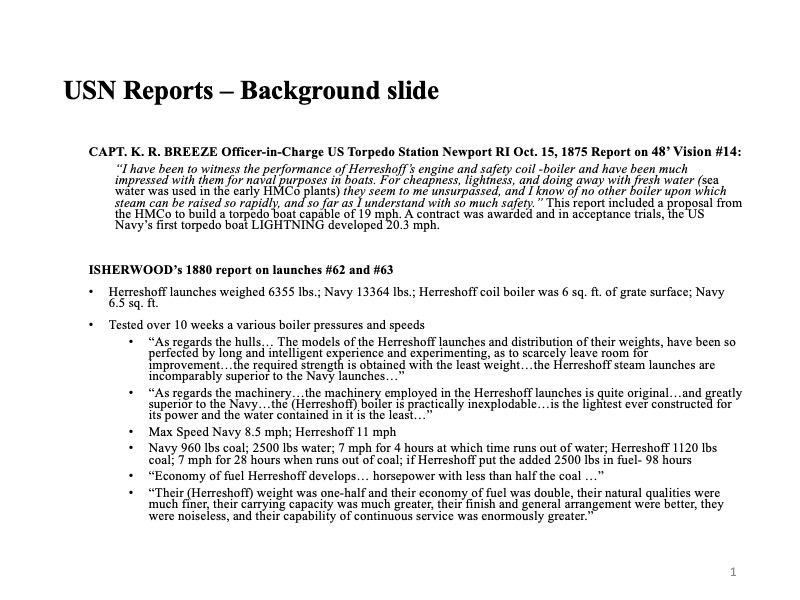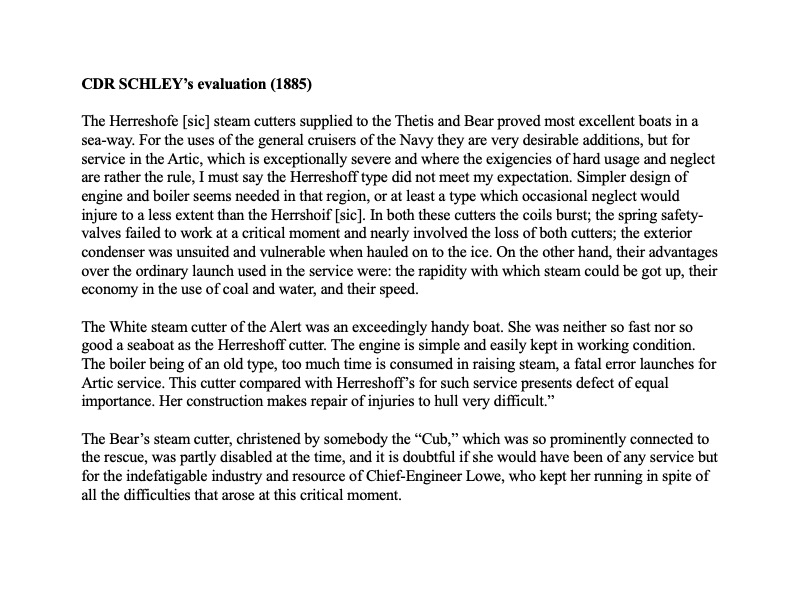So what did this steam plant mean competitively?
From W.P. Stevens book "Traditions and Memories of American Yachting," page 230:
"In 1887 Commander W.B. Hoff, USN, of the USS Ossipee made a disparaging comparison between working Navy launches as draft horses and Herreshoff Navy launches as racehorses. This challenge was taken up by Captain Bruce, USN, of the USS Atlanta when at Bristol, using the Herreshoff launch of Atlanta and Navy launch of Ossipee. The two launches were joined by a hawser over their sterns, and both started. The Herreshoff launch first stopped the Navy launch and then towed her stern-first faster than Captain Bruce in the Navy launch could keep up with them."
(Atlanta launch delivered in 1886 had a double expansion engine with "F' sized square boiler. Just a year before USS Chicago received its Herreshoff launch with Herreshoff's first triple expansion engine. Both would have had square boilers.)
We know that Herreshoff had a close relationship with the technical side of the US Navy and that they wrote glowing reports about his launches but this did not result in large numbers of sales. Sales were made for USS Essex, #70 1880, USS Hartford, #111 1884, and the Navy's first modern steel ships, the "ABCD" ships of evolution USS Atlanta, #132, USS Boston, #115 1884, USS Chicago, #128, and USS Dolphin, #106 1884.) Of importance, Herreshoff launches #108 and #109 were designated for the Navy's mission in 1884 to rescue survivors of Army Lt Greeley's Artic exploration party.
And of course there was spar torpedo boat test vehicle Lightning, #20 1874, and Stiletto, #118 1885, acquired by the Navy in 1887. Stiletto was to steam what Herreshoff's Gloriana was to racing sailing yachts. It raced from NYC to Albany against the 300' Hudson River steamer Mary Powell, running circles around her. At the time Mary Powell was the fastest vessel on the Hudson and perhaps worldwide. Interestingly, the navy would quickly replace Stiletto's square boiler with a Thorneycroft type manufactured by Almy who had earlier been Herreshoff's boiler department supervisor!
I enclose US Navy detailed notes on evaluations of Herreshoff launches.
So why is all this important. It isn't just about the power plant!
USN Capt. Converse notes in his evaluation of Lightning that Capt. Nat was doing model tow testing of efficient hull shapes (1876), L Francis Herreshoff will observe that #24 (1876) for Bureau of Ordnance was Capt. Nat's first attempt at the modern hull shape, and certainly by 1887 we know he was tow-testing in Bristol harbor. We also know from LFH that Capt. Nat designed all his own propellers and that he perfected light-weight wooden boat design on davit launches. From Reliance team observations and research and from LFH we also have a pretty good idea of the sophistication of HMCo engineering and manufacturing processes and capabilities to produce advanced steam systems and complex metal hull yachts and torpedo boats.
1878-1892 was HMCo's age of steam. it was not until Gloriana and Dilemma in 1891 and 1892 America's Cup boats that HMCo turned to sail. Thus, the steam years serve as the bedrock upon which sail was built!




